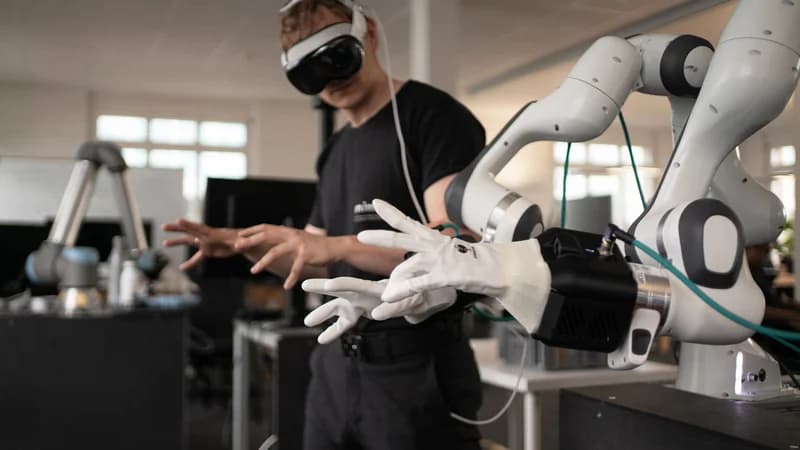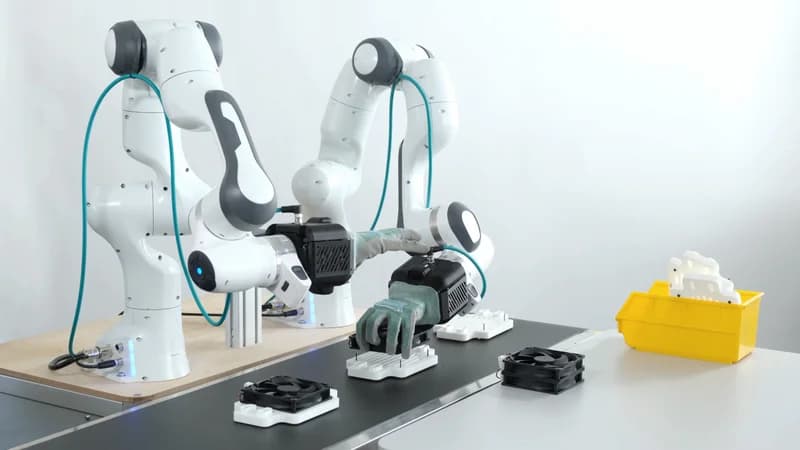- Published on
Mimic Robotics Raises $16M to Pair Dexterous AI Hands With Standard Robot Arms

ZURICH — Mimic, a robotics and AI company founded in 2024 as a spin-off from ETH Zurich, announced today it has raised a $16 million seed round. The company aims to deploy "frontier physical AI" to automate complex, dexterous tasks in industries like manufacturing, assembly, and logistics.
The heavily oversubscribed round was led by European venture firms Elaia and Speedinvest, with participation from Founderful, 1st kind, 10X Founders, 2100 Ventures, and the Sequoia Scout Fund. This brings Mimic's total funding to over $20 million.
Mimic's strategy wades directly into one of robotics' most active debates: what is the best way to automate physical labor?
Instead of building full-body humanoid robots, Mimic is focusing on what it considers the most critical components: AI-driven "humanoid robotic hands" and the AI models that control them. These hands are designed to be paired with "proven, off-the-shelf robot arms," bypassing the complexity of developing bipedal locomotion.
"Humanoids are exciting, but there aren’t many industrial scenarios where the full-body form factor truly adds value," said Stephan-Daniel Gravert, co-founder and CPO at Mimic, in the press release. "Our approach pairs AI-driven dexterous robotic hands with proven, off-the-shelf robot arms to deliver the same capabilities in a way that is much simpler, more reliable and rapidly deployable."
This pragmatic argument echoes the skepticism voiced by some in the field, who question the current industry-wide push for general-purpose, human-shaped machines.
An AI Model Trained on Human Data
The core of Mimic's technology is its "frontier physical AI model." To solve the data scarcity problem that has long plagued robotics, the company uses proprietary data-collection devices. Skilled human operators wear these devices while performing their normal jobs on the factory floor, allowing Mimic to capture detailed movement data from live production settings without disrupting operations. Read our comparison of other data-collection strategies here: The Physical AI Bottleneck: Comparing the Data Strategies.
This data is then used to train the AI models via imitation learning, enabling the company's robotic hands to reproduce human techniques. Mimic claims its models can autonomously react to changing object positions, handle disturbances, and self-correct in environments designed for people.
"Our general purpose AI models allow us to automate manual labour in a way that simply was not possible before," said Elvis Nava, co-founder and CTO.

A Growing Market for Hands
The new capital will be used to accelerate the development of Mimic's AI foundation model and robotic hands, as well as to advance deployments with its pilot customers. The company states it is already working with Fortune 500 manufacturers, global automotive brands, and multinational logistics providers.
Mimic's launch adds another serious contender to the rapidly heating-up market for dexterous robotic end-effectors. Humanoids Daily has recently covered several new entrants in this space:
- Sharpa Robotics: This company recently began shipping its SharpaWave hand, which is built around achieving human-level performance through advanced, high-resolution tactile sensing.
- Wuji Tech: Wuji's 20-DOF hand has drawn attention for its lightweight design and its "remarkably robust" direct-drive actuation system, which places motors directly in the fingers rather than using a complex tendon-based approach.
While competitors are focusing heavily on specific hardware innovations—like sensing or actuation—Mimic is pitching its primary differentiator as the AI model and its unique, real-world data acquisition pipeline.
The company's investors see this as a key advantage. "Mimic’s breakthrough approach integrates a proprietary robotic hand, state-of-the-art foundation models for robotics, and novel data acquisition and training methods," said Clément Vanden Driessche, Partner at Elaia.
Andreas Schwarzenbrunner, General Partner at Speedinvest, added, "This is the moment Europe steps forward to compete and lead in the new era of AI and robotics."
Share this article
Stay Ahead in Humanoid Robotics
Get the latest developments, breakthroughs, and insights in humanoid robotics — delivered straight to your inbox.